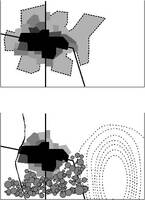- England
- Scotland
- France
- Holland
- Germany
- Italy
- Spain
- Portugal
- USA
- China
- Japan
- India
- Iran
- Advice
- Gardens
- England
- Scotland
- France
- Holland
- Germany
- Italy
- Spain
- Portugal
- USA
- China
- Japan
- India
- Iran
- Advice
- Garden Tours
Book: Landscape Planning and Environmental Impact Design: from EIA to EID
Chapter: Chapter 11 Urbanisation and growth management
The present trend towards extinction of the small village is sure to continue, unless new settlements are started. Increases in population lead to larger settlements, as do increases in wealth. Wealth creates a desire for more space: bigger shops, schools, museums, houses, parks, gardens and everything. If we allow existing settlements to grow and grow, without starting new settlements, everyone will end up living in a metropolis, which is not what everyone wants. The planning system is far from neutral as a determinant of settlement size. In Japan, it has led to the protection of agricultural and forest lands, so that cities have become extremely large and extremely dense. In America, zoning laws have led to large low-density cities. In Britain, planning laws led to the establishment of 35 'new towns' after 1945 but then stopped the process of new town creation. Existing settlements have been allowed to expand instead. Villages are becoming towns; small towns are becoming large towns; large towns are becoming conurbations. This is regrettable. Whether or not large towns are desirable, one can hardly dispute that villages and small towns are also desired, and that any planned growth should be located with regard to existing landscape features [Fig 11.5]. 11.5 If villages keep growing (above), they will become large towns. Their boundaries should be related to landscape considerations (below). This not done for 'village envelopes' in the UK. A respectable case can be made for a society to adopt a 'no growth' policy. But if populations do grow, which is sufficiently certain to necessitate contingency planning, we should make plans for new settlements. In Britain, the 1946 New Towns Act should be re-activated. Other countries should use other legislation to facilitate the selection, assessment and acquisition of the most suitable land for urbanisation.
